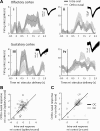Single-neuron responses to intraoral delivery of odor solutions in primary olfactory and gustatory cortex
- PMID: 28003413
- PMCID: PMC5349332
- DOI: 10.1152/jn.00802.2016
Single-neuron responses to intraoral delivery of odor solutions in primary olfactory and gustatory cortex
Abstract
Smell plays a major role in our perception of food. Odorants released inside the mouth during consumption are combined with taste and texture qualities of a food to guide flavor preference learning and food choice behavior. Here, we built on recent physiological findings that implicated primary sensory cortex in multisensory flavor processing. Specifically, we used extracellular recordings in awake rats to characterize responses of single neurons in primary olfactory (OC) and gustatory cortex (GC) to intraoral delivery of odor solutions and compare odor responses to taste and plain water responses. The data reveal responses to olfactory, oral somatosensory, and gustatory qualities of intraoral stimuli in both OC and GC. Moreover, modality-specific responses overlap in time, indicating temporal convergence of multisensory, flavor-related inputs. The results extend previous work suggesting a role for primary OC in mediating influences of taste on smell that characterize flavor perception and point to an integral role for GC in olfactory processing.NEW & NOTEWORTHY Food perception is inherently multisensory, taking into account taste, smell, and texture qualities. However, the neural mechanisms underlying flavor perception remain unknown. Recording neural activity directly from the rat brain while animals consume multisensory flavor stimuli, we demonstrate that information about odor, taste, and mouthfeel of food converges on primary taste and smell cortex. The results suggest that processing of naturalistic, multisensory information involves an interacting network of primary sensory areas.
Keywords: electrophysiology; flavor; gustatory cortex; multisensory; olfactory cortex.
Copyright © 2017 the American Physiological Society.
Figures








Similar articles
-
Processing of Intraoral Olfactory and Gustatory Signals in the Gustatory Cortex of Awake Rats.J Neurosci. 2017 Jan 11;37(2):244-257. doi: 10.1523/JNEUROSCI.1926-16.2016. J Neurosci. 2017. PMID: 28077705 Free PMC article.
-
Multisensory Integration Underlies the Distinct Representation of Odor-Taste Mixtures in the Gustatory Cortex of Behaving Rats.J Neurosci. 2024 May 15;44(20):e0071242024. doi: 10.1523/JNEUROSCI.0071-24.2024. J Neurosci. 2024. PMID: 38548337 Free PMC article.
-
Chemosensory convergence on primary olfactory cortex.J Neurosci. 2012 Nov 28;32(48):17037-47. doi: 10.1523/JNEUROSCI.3540-12.2012. J Neurosci. 2012. PMID: 23197697 Free PMC article.
-
The gustatory cortex and multisensory integration.Int J Obes (Lond). 2009 Jun;33 Suppl 2(Suppl 2):S34-43. doi: 10.1038/ijo.2009.70. Int J Obes (Lond). 2009. PMID: 19528978 Free PMC article. Review.
-
Odor/taste integration and the perception of flavor.Exp Brain Res. 2005 Oct;166(3-4):345-57. doi: 10.1007/s00221-005-2376-9. Epub 2005 Jul 19. Exp Brain Res. 2005. PMID: 16028032 Review.
Cited by
-
Cortical Hub for Flavor Sensation in Rodents.Front Syst Neurosci. 2021 Nov 15;15:772286. doi: 10.3389/fnsys.2021.772286. eCollection 2021. Front Syst Neurosci. 2021. PMID: 34867223 Free PMC article. Review.
-
Central taste anatomy and physiology.Handb Clin Neurol. 2019;164:187-204. doi: 10.1016/B978-0-444-63855-7.00012-5. Handb Clin Neurol. 2019. PMID: 31604547 Free PMC article. Review.
-
Retronasal Odor Perception Requires Taste Cortex, but Orthonasal Does Not.Curr Biol. 2019 Jan 7;29(1):62-69.e3. doi: 10.1016/j.cub.2018.11.011. Epub 2018 Dec 20. Curr Biol. 2019. PMID: 30581018 Free PMC article.
-
Oral thermal processing in the gustatory cortex of awake mice.Chem Senses. 2023 Jan 1;48:bjad042. doi: 10.1093/chemse/bjad042. Chem Senses. 2023. PMID: 37850853 Free PMC article.
-
Cortical Coding of Gustatory and Thermal Signals in Active Licking Mice.bioRxiv [Preprint]. 2024 Nov 14:2024.04.27.591293. doi: 10.1101/2024.04.27.591293. bioRxiv. 2024. Update in: J Physiol. 2025 Feb;603(4):909-928. doi: 10.1113/JP287499. PMID: 39185224 Free PMC article. Updated. Preprint.
References
-
- Bouton ME, Jones DL, Mcphillips SA, Swartzentruber D. Potentiation and overshadowing in odor-aversion learning–role of method of odor presentation, the distal-proximal cue distinction, and the conditionability of odor. Learn Motiv 17: 115–138, 1986. doi:10.1016/0023-9690(86)90006-8. - DOI
Publication types
MeSH terms
Grants and funding
LinkOut - more resources
Full Text Sources
Other Literature Sources
Medical
Miscellaneous

